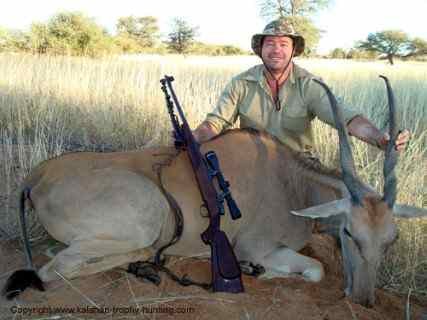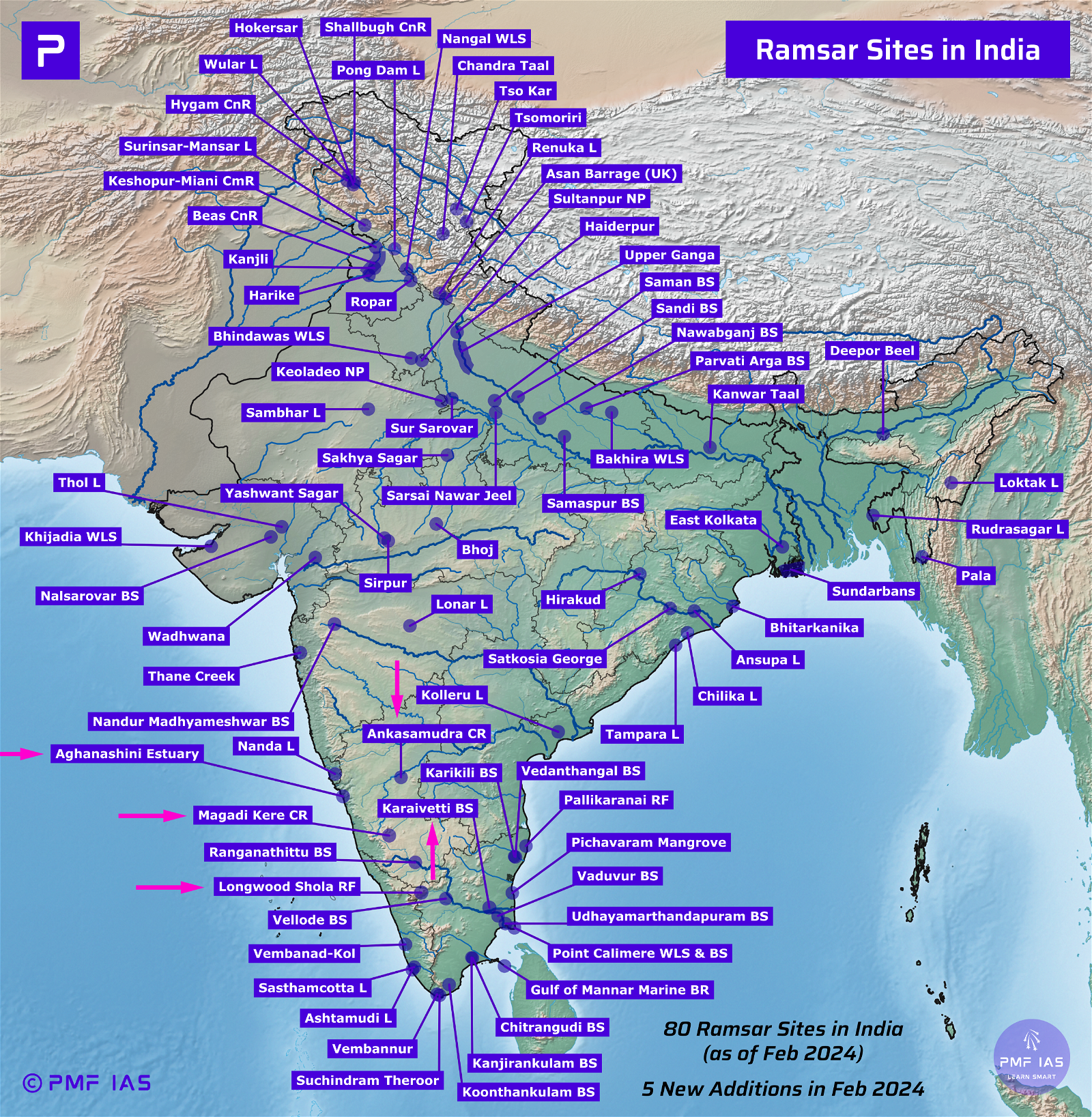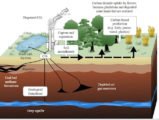
Biodiversity Loss: Habitat Fragmentation & Man-Animal Conflict
Subscribe to Never Miss an Important Update! Assured Discounts on New Products!
Must Join PMF IAS Telegram Channel & PMF IAS History Telegram Channel
Last updated on April 26, 2024 7:22 PM
Loss of Biodiversity
- The IUCN Red List (2004) documents the extinction of 784 species in the last 500 years.
- Some examples of recent extinctions include the three subspecies (Bali, Javan, Caspian) of tiger.
- During the long period (> 3 billion years) since the origin and diversification of life on earth, there were five episodes of mass extinction of species.
- Sixth Extinction (anthropogenic) presently is in progress with current species extinction rates estimated to be 100 to 1,000 times faster than in the pre-human times.
- Ecologists warn that if the present trends continue, nearly half of all the species on earth might be wiped out within the next 100 years.
- In general, loss of biodiversity in a region may lead to
- decline in plant production,
- lowered resistance to environmental perturbations such as drought and
- increased variability in certain ecosystem processes such as plant productivity, water use, and pest and disease cycles.
Cause for the loss of biodiversity
- There are four major causes – The Evil Quartet – Habitat loss, Overexploitation, Alien species and Secondary extinction.
Habitat loss and fragmentation
- This is the most important cause of driving animals and plants to extinction.
- Due to the growing human population, wetlands are being made dry through landfills, as the demand for land increases.
- Natural forests are cleared for industry, agriculture, dams, habitation, recreational sports, etc.
- The most dramatic examples of habitat loss come from tropical rain forests.
- Once covering more than 14 per cent of the earth’s land surface, these rain forests now cover no more than 6 per cent. They are being destroyed fast.
- The Amazon rain forest (it is so huge that it is called the ‘lungs of the planet’) harbouring probably millions of species is being cut and cleared for cultivating soya beans or for conversion to grasslands for raising beef cattle.
Man-Animal Conflict
- It refers to the interaction between wild animals and people and the resultant negative impact on people or their resources, or wild animals or their habitat.
- It occurs when wildlife needs overlap with those of human populations, creating costs to residents and wild animals.
Causes
- Human population growth and encroachment into forest lands.
- Land use transformation – industrialization, infrastructure development, commercial farming etc.
- Species habitat loss, degradation and fragmentation due to above-mentioned reasons.
- Increasing livestock populations and competitive exclusion of wild herbivores.
- Growing interest in ecotourism and increasing access to nature reserves.
- Abundant distribution of prey in the form of livestock on the periphery of forest lands.
- Increasing wildlife population as a result of conservation programmes.
- Climatic factors – climate change-induced habitat destruction.
- Stochastic events (e.g. fire, floods etc.)
Impacts
- Crop damage and damage to property – elephants damage crops and villages.
- Livestock depredation – Himalayan snow leopard preys on goats in the Himalayan region. Farmers trap and kill snow leopards to save their livestock.
- Injuries and deaths – Man eater tigers, are reported to have injured and killed villagers living on the periphery.
- Injuries to wildlife – leopards and other wild animals are hacked to death by mobs.
Preventive and Mitigation strategies
- Artificial and natural barriers (physical and biological) – very expensive.
- Guarding – very expensive.
- Alternative high-cost livestock husbandry practices
- Relocation: voluntary human population resettlement.
- Waste management systems that restrict wildlife access to refuse.
- Community-based natural resource management schemes (CBNRMS)
Culling of animals – Conservation or Biodiversity loss?
Natural culling
- Culling means ‘Selection’.
- In the wild, it is the process of weeding out of the weak.
- A population boom makes individuals compete for food and safety, and the weaker ones lose out, leaving a smaller population of more able individuals.
- Culling naturally occurs by starvation, disease and predation. It is nature’s way of controlling population.
Culling by humans – controlled culling
- In the post-conservation era, human intervention became necessary for the management of wildlife populations through controlled hunting, which is now referred to as culling.
Why did controlled culling become necessary?
- Man-Animal conflict – too many wild animals compete with humans for resources.
- Threat to life and livelihood (crop, property damage) makes culling necessary.
- Loss of forestland to mines, industry, agriculture, etc. is the primary reason behind the man-animal conflict.
- Crop-raiding by smaller herbivores due to a population boom & animals raiding nutrient-rich crops like wheat and maize are other major reasons for man-animal conflict.
The practice of Culling worldwide
- In the US, some areas require seasonal culling to ease pressure on livestock feed.
- In parts of Africa, culling has been used for commercial harvesting.
- Australia culls feral cats to protect native species.
- Australia also culls kangaroos.
Animal welfare activists vs Pro culling lobby
- Culling lobby: Affected farmers and government administration.
| Arguments by animal welfare activists against culling | Arguments by Culling lobby |
|
|
|
|
|
|
|
|
|
|
|
|
|
|
Over-exploitation
- Humans have always depended on nature for food and shelter, but when ‘need’ turns to ‘greed’, it leads to over-exploitation of natural resources.
- In the last 500 years, many species extinctions (Steller’s sea cow, passenger pigeon) were due to overexploitation by humans.
- Presently many marine fish populations around the world are over-harvested, endangering the continued existence of some commercially important species.
- Whales for oil, fish for food, trees for wood, plants for medicines etc. are being removed by humans at higher rates than they can be replaced.
- Excessive cutting of trees, overgrazing, collection of firewood, hunting of wild animals for skin (for example tigers from reserve forests of India), ivory etc. all result in gradual loss of species.
Poaching
- Large mammals such as the tiger, rhinoceros and the elephant once faced the distinct possibility of complete extinction due to rampant hunting and poaching.
- Global warming (Climate change), natural calamities are other reasons for loss of biodiversity.
Alien species invasions
- When alien species are introduced unintentionally or deliberately for whatever purpose, some of them turn invasive and cause decline or extinction of indigenous species.
- The Nile perch introduced into Lake Victoria in East Africa led eventually to the extinction of an ecologically unique assemblage of more than 200 species of cichlid fish in the lake.
- You must be familiar with the environmental damage caused and threat posed to our native species by invasive weed species like carrot grass (Parthenium), Argemone, Lantana and water hyacinth (Eicchornia).
- The recent illegal introduction of the African catfish Clarias gariepinus for aquaculture purposes is posing a threat to the indigenous catfishes in our rivers.
- The colonization of tropical Pacific Islands by humans is said to have led to the extinction of more than 2,000 species of native birds.
Some Invasive fauna in India are
- Eucalyptus in Southern India.
- Gold Fish
- House Gecko
Species Extinction
- Extinction is caused through various processes:
- Deterministic processes that have a cause and effect. E.g. glaciations, human interference such as deforestation.
- Stochastic processes (chance and random events) that affect the survival and reproduction of individuals. E.g. unexpected changes in weather patterns decreased food supply, disease, increase of competitors, predators or parasites, etc. that may act independently or add to deterministic effects.
- The impact of these processes will, of course, depend on the size and degree of genetic diversity and resilience of populations.
- Traits that adversely affect or increase a species vulnerability to extinction due to habitat fragmentation have been identified. These are:
- rarity or low abundance
- poor dispersal ability
- high trophic status – as animals occupying a higher trophic level (i.e. the position of a species in a food chain) usually have smaller populations than those at lower levels (e.g. carnivores are fewer in number than herbivores)
- low adult survival rates
Co-extinctions
- When a species becomes extinct, the plant and animal species associated with it in an obligatory way also become extinct.
- When a host fish species becomes extinct, its unique assemblage of parasites also meets the same fate.
- Another example is the case of a coevolved plant-pollinator mutualism where extinction of one invariably leads to the extinction of the other.
Last updated on April 26, 2024 7:22 PM




![PMF IAS Environment for UPSC 2022-23 [paperback] PMF IAS [Nov 30, 2021]…](https://pmfias.b-cdn.net/wp-content/uploads/2024/04/pmfiasenvironmentforupsc2022-23paperbackpmfiasnov302021.jpg)













